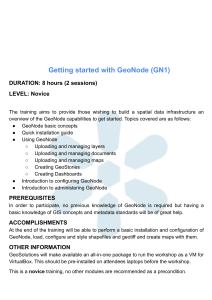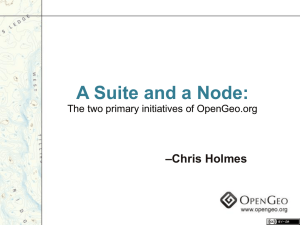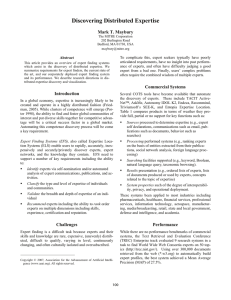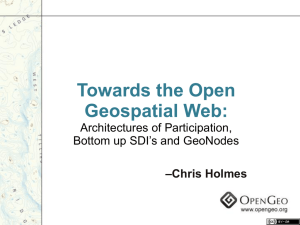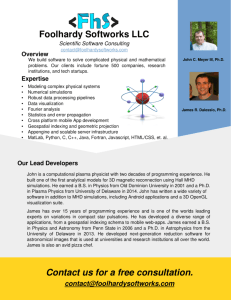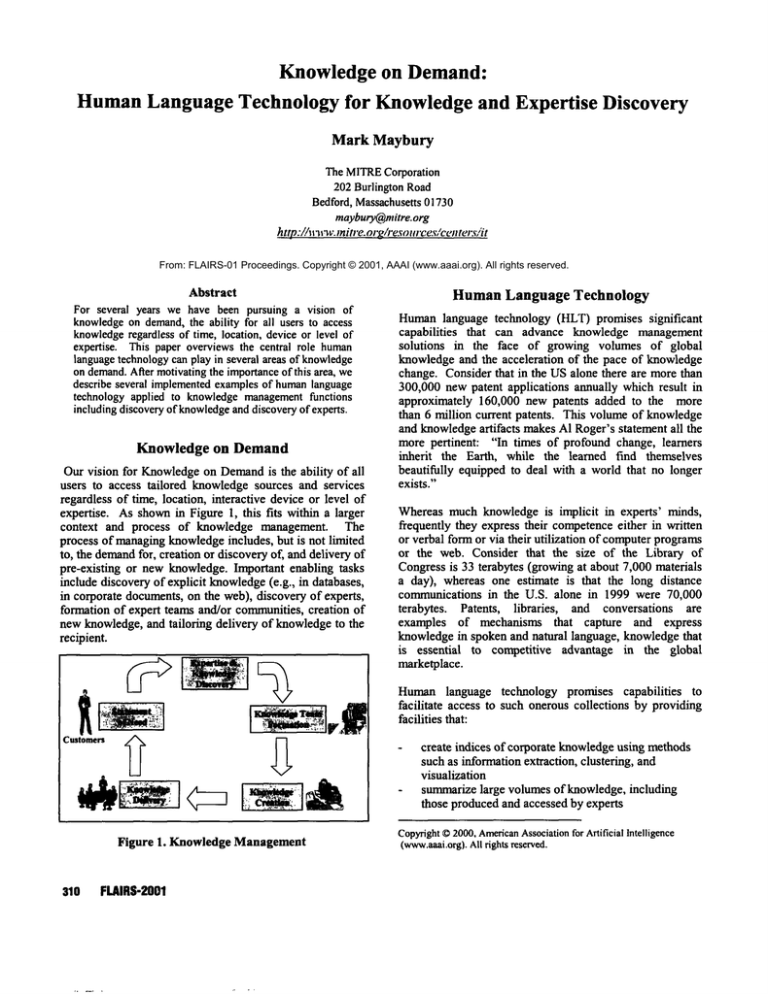
Knowledge on Demand:
HumanLanguage Technology for Knowledge and Expertise Discovery
Mark Maybury
The MITRE
Corporation
202 Burlington Road
Bedford, Massachusetts01730
maybury@mitre.org
http.’//www.mitre.org/resources/center.s;/it
From: FLAIRS-01 Proceedings. Copyright © 2001, AAAI (www.aaai.org). All rights reserved.
Abstract
For several years we have been pursuing a vision of
knowledgeon demand,the ability for all users to access
knowledgeregardless of time, location, device or level of
expertise. This paper overviewsthe central role human
languagetechnologycan play in several areas of knowledge
on demand.After motivatingthe importanceof this area, we
describe several implementedexamplesof humanlanguage
technology applied to knowledgemanagementfunctions
includingdiscoveryof knowledge
and discoveryof experts.
Knowledge on Demand
Our vision for Knowledgeon Demandis the ability of all
users to access tailored knowledgesources and services
regardless of time, location, interactive device or level of
expertise. As shownin Figure 1, this fits within a larger
context and process of knowledge management. The
process of managingknowledgeincludes, but is not limited
to, the demandfor, creation or discoveryof, and delivery of
pre-existing or new knowledge. Important enabling tasks
include discovery of explicit knowledge(e.g., in databases,
in corporate documents,on the web), discovery of experts,
formation of expert teams and/or communities, creation of
new knowledge, and tailoring delivery of knowledgeto the
recipient.
HumanLanguage Technology
Humanlanguage technology (HLT) promises significant
capabilities
that can advance knowledge management
solutions in the face of growing volumes of global
knowledgeand the acceleration of the pace of knowledge
change. Consider that in the USalone there are more than
300,000 new patent applications annually which result in
approximately 160,000 new patents added to the more
than 6 million current patents. This volumeof knowledge
and knowledgeartifacts makesAI Roger’s statement all the
more pertinent: "In times of profound change, learners
inherit the Earth, while the learned find themselves
beautifully equipped to deal with a world that no longer
exists."
Whereas muchknowledge is implicit in experts’ minds,
frequently they express their competenceeither in written
or verbal form or via their utilization of computerprograms
or the web. Consider that the size of the Library of
Congressis 33 terabytes (growing at about 7,000 materials
a day), whereas one estimate is that the long distance
communications in the U.S. alone in 1999 were 70,000
terabytes. Patents, libraries,
and conversations are
examples of mechanisms that capture and express
knowledgein spoken and natural language, knowledgethat
is essential to competitive advantage in the global
marketplace.
Humanlanguage technology promises capabilities
to
facilitate access to such onerous collections by providing
facilities that:
create indices of corporate knowledgeusing methods
such as information extraction, clustering, and
visualization
summarizelarge volumesof knowledge, including
those produced and accessed by experts
Figure 1. Knowledge Management
310
FLAIRS-2001
Copyright
©2000,American
Association
for ArtificialIntelligence
(www.aaai.org).
Allrightsreserved.
transcribe audio or video sources whichoften capture
expert communicationsand/or lessons learned
translate foreign languagematerial enabling access to
global knowledgesources
generate profiles of experts using language processing
to enable automatedexpert finding
facilitate communitiesof interest by classifying and
tracking public user and group interests and sharing
these to enhance group awareness
Wehave developed and deployed a range of applications
that take advantage of humanlanguage. This paper focuses
on the challenge of global and corporate knowledge
management
and outlines experience with intelligent tools
that support:
-
automated detection and tracking of emergingtopics
from unstructured multimedia data
automateddiscovery of distributed experts and
communitiesof expertise, and
capabilities to increase organizational awareness(e.g.,
awareness of team membersand materials in virtual
collaboration environments).
To illustrate these areas concretely, we overview several
implemented and evaluated systems. Figure 2 illustrates
howthese applications are envisioned to work together to
facilitate knowledgeon demand.Overall, the systems work
together to enable a user to retrieve multimediadocuments,
extract information from those, summarizetheir contents,
translate themif they are in a foreign language, cluster and
mine related collections of documents, or browsewithin a
geospatial context collections of documentsor information
extracted from those documents (e.g., topics, names,
locations). In addition, we have a need to find experts and
facilitate their collaboration and enable new knowledge
creation.
Disseminate/
Retrieve
(BNN,
Extract
QANDA)
(Alembic,
(WebSumm)
Sell,i°)
BrowseN|sua|ize
Collaborate
(GeoNODE)
(ExpertFinder. XperNet)
Translate
Monitor
(SIAM)
Cluster/Mine
(QueryFIocks)
Figure 2. HumanLanguage Technologies for
Knowledge Management
In the remainder of the paper we describe several of the
systems in Figure 2 including Geospatial NewsOn Demand
Environment (GeoNODE)(Hyland et al. 1999), Expert
Finder, XperNetand the Collaborative Virtual Work,space
(CVW). GeoNODE
automatically detects and extracts
emerging topics from web, document, and video news
broadcast collections using a unique underlying data
mining algorithm (QueryFlocks). The Broadcast News
Navigator (BNN)provides content-based access to news
for GeoNODE. The Semio system, which we do not
describe, similarly provides automated extraction and
visualization from unstructured data, to include browsing
by topic in a Yahoo-like fashion across ingested
collections.
QANDA
is a question answering system
(Breck et al. 2000) and WebSumm
summarizes documents.
CyberTrans provides document translation
on demand
using a range of commercial translation engines. Expert
Finder is a people skill finder that exploits the intellectual
products created within an enterprise to support automated
expertise classification. XperNetaddresses the problemof
detecting extant or emerging communities of human
expertise without a priori knowledgeof their existence.
Both ExpertFinder and XperNet combine to detect and
track experts and expert communities within a complex
work environment. CVW
(cvw.soureforge.net) is a placebased collaboration
environment that enables team
membersto find one another and work together. These are
described in turn.
Knowledge
Discovery
Given rapid knowledgecreation and dissemination, a key
technical challenge is dealing with large, heterogeneous
collections of knowledge in a uniform manner. Wehave
beenexploring a range of analytic support tools to facilitate
users in discovering and accessing knowledgeon demand.
Becausethese tools are fully automated, we are limited to
discovering knowledgethat is explicit in artifacts and can
be extracted, to include information about people, places,
organizations, and events. For example,Figure 3 illustrates
the architecture
of MITRE’s GeoNODE.GeoNODE
aims
to provide uniform access to unstructured multimedia(i.e.,
text, audio, and video) from such sources as document
repositories, broadcast news (e.g., CNN,MS-NBC),and
the WorldWide Web. Following initial data preprocessing
(possibly including speech transcription) into a common
format (e.g., to delineate segmentsof stories, webpages, or
messages), multilingual information extractors tag named
entities (e.g., names of people, organizations, and
locations) as well as relations amongthese (Aberdeenet al.
1995). These namedentities are then clustered according
to co-occurrence within segments and then a graph analysis
routine is used to further segment these clusters into
"topics". The most frequently occurring named entities
within each topic cluster becomethe topic label for that set
of entities, whichin turn point back to source segments.
KNOWLEDGE
MANAGEMENT311
Information
Sources
~.
[" ~-Navioate
.Filter
/ ~ii~
/ ,
1"
.Indexed
access
i
I .......
...
L ........
.......
.....
~ I
.Animatereportingbends~ ~,/
.Crealereporl~web
/~
......
":’,:/’~
I .......
l ....
"
(bottom left hand lisO. Notice how topics discovered by
GeoNODE
are labeled using the most frequently occurring
namedentities in the clusters. In this case the topic cluster
"Afghanistan, Kenya, Nairobi, Tanzania" refers to
documents concerning the US embassy bombings and the
topic cluster "Afghanistan, Khartoum,Ladin, Sudan"refers
to stories regarding the USair strike response. Whenthen
user selects (highlights) topic clusters, GeoNODE
displays
the intervals of occurrence in the top display of Figure 5.
Selection of clusters enables direct access to the underlying
documentsforming the topic as well as other services such
as translation or stLmmarization.
Figure 3. Geospatial Newson DemandArchitecture
This unique pipeline results
in uniform direct
access/visualization across the heterogeneous
sources. As
Figure 3 suggests, this enables a range of customizedviews
including the ability to visualize newsevents temporally as
well as geospatially across sources.
Using this
heterogeneous access, an information analyst can quickly
assess key individuals and events reported from a range of
publications across sources. For example, this would
enable a financial analyst to track local business and
governmentleaders, corporations, and key economicevents
to assess the financial state of a region.
Figure 4 illustrates a simple visualization over a six month
period of the occurrencesof reporting on a topic (i.e., the
number of detected stories) across two broadcast news
sources (CNN World View and CNN World Today).
Interactive tools allow the user to quickly zoom in on
relevant time periods to focus on unusual or interesting
levels of reporting on particular detected topics.
Figure 5. TemporalVisualization of
Automatically NominatedTopics
A final form of visualization is a custom generated
ArcViewGis cartographic display. Figure 6 illustrates how
a user can take a particular set of documentsassociated
with an identified topic and visualize the frequency of
mentions of locations in documents on those topics. For
example, Figure 6 shows a heavy concentration
of
reporting on Indian and Afghanistanon the topic of nuclear
testing. Shades of brown indicate topics reported about
regions (e.g., a country) whereas yellow circles display
concentrationsof reporting in particular cities.
Figure 4. Visualizing Relevant Stories by Source
A more sophisticated
visualization
displays topic
occurrences over time. In the visualization in Figure 5, the
user has selected the two-year timeframe from October
1996 until November of 1998. GeoNODEdisplays
automatically discovered topics (list on bottom right of
Figure 5) that are reported across particular newsprograms
312
FLAIRS-2001
Figure 6. Geospatial Visualization
In summary,temporal, spatial and topical visualizations
enable the user direct access to extracted knowledgeto
support rapid browsing, comparison, anomaly and pattern
detection.
Expert Finding and CommunityDiscovery
While access to extracted information and discovered
relationships is important, muchknowledgeis not captured
explicitly, but rather implicitly resides in processes,
procedures, or experts’ heads. Humanlanguage technology
can facilitate implicit knowledgediscovery by extracting
information about experts from their writings or in others
writings about them. This was precisely the aim of
ExpertFinder (Mattox et al. 1999). Given a simple user
query, such as "Find me all experts on multimedia
databases", ExpertFinder analyzes the most frequently
occurring keywords from documents users have published
(e.g., resumes, documents, briefings). ExpertFinder also
processes corporate newsletters to extract individual names
and associated topics that are reported (e.g., a report of an
expert presenting a paper at a conference on a particular
topic or an interview with an expert). With a database of
namesassociated with topics, the system can nowprovide
expert finding services. Figure 7 illustrates ExpertFinderin
action, providing a rank ordered list of "multimedia
database" experts based on the frequency and type of
evidence the system compiles on their expertise. In Figure
7, the sources of evidence, including links to the original
documentor data is listed in the bottom right hand comer.
A keywordappearing in a resumeor in the title of a project
for which an individual is a principal investigator is more
strongly weighted that the user posting a document
containing the keyword. An empirical evaluation of the
system (Mayburyet al. 2000) in five diverse technical
domains found the system to perform approximately one
third as well as resource managers.
People publishing documents contakdag the term:
’mnltlmedla database’
People with Publi©ations
Score Photo Name
De
.13 g Lar~nee,P~hard
1 "’"
"1
"I
g
3
~,dvev.]~a~d
’.z..
.’g .Thoma~,L,,’aell$
Place-based Collaboration
Part of our vision of providing knowledge on demand
includes virtual place-based work places that enable users,
regardless of location or time zone, to collaborate
synchronously or asynchronously. Figure 8 illustrates the
Collaborative Virtual Workplace (cvw.sourceforge.net)
which integrates
services such as audio/video/text
conferencing, data sharing, and navigation within a virtual
office building containing other users, documentsand tools.
As evident even in Figure 8, one major issue is awareness
of information sources and users. A range of mechanisms
are provided to facilitate awarenessof documents(e.g., in
the Figure note the labels "Private Data" and "Shared
Data"), people (e.g., "Online Users" list, "Users
Room"), and user activities (e.g., "Shared WebBrowsing"
and "Shared Whiteboard" with user labeled cursors). Even
given these facilities, services such as avatars that enable
tracking and alerting of events in other roomsare invoked
by users to enhancetheir awarenessof people, information,
and events. We believe tools such as GeoNODE
will
enable more effective browsing of knowledge related to
entities
and events in such environments. Further,
ExpertFinder and XperNetsupport rapid discovery of those
whoare not virtually present or perceptible, enabling rapid
team formation.
Future Research
D5
C,C
[C.~
:GC
Humanlanguage technology can further enable us to
discover not only individual experts but also communities
of practicing experts. The XperNet system (Maybury,
D’Amoreand House, forthcoming) performs its analysis on
similar sources as ExpertFinder but clusters users into
affinity groups on basis of membership computations.
Higher levels of expertise are associated with factors such
as document authorship, explicit reference or citation,
network centrality,
personal Webpages, and project
membership.Lowerexpertise levels reflect fewer expertise
indicators and possibly counter-indications such as being a
member of the non-technical staff. In an empirical
evaluation, XperNet found 70% of manually identified
experts (precision) and was 60%correct in its assessment
that someonewas an expert (recall).
Documents Published:
¯ c.dt~C00
¯ "IT.r’LEL.:m*~.ta~’sCor~cy
Asse,.smLnt
Tool,~t.LOC*,TAT)
¯ to~2
iiiiiiii
ii
Figure 7. Expert Finder
While there are many disincentives to our vision of
knowledge on demand (e.g., scarce expertise, lack of
awareness of expertise, validation of expertise, time for
knowledgediscovery and expert interaction), tools for
better accessing and extracting explicit knowledgepromise
to ameliorate some of these impediments. Manyresearch
issues remain open including domain independent event
detection and tracking, dynamic creation of expert and
expert social models, knowledge delivery tailored to
individual expertise,
and heterogeneous knowledge
integration.
We have only begun to explore the
possibilities for humanlanguage technologies to enable
knowledge on demand.
KNOWLEDGE
MANAGEMENT 313
Text
Chat
Users
in Room
Shared
Data
Conferencing
Conferencin
g
Floor Plan
Figure 8. Collaborative Virtual Workplace
References
Aberdeen, A., Burger, J., Day, D., Hirschman, L.,
Robinson, P. & Vilain, M. 1995. MITRE:Description of
the Alembic System as Used for MUC-6.In Proceedings of
the Sixth Message Understanding Conference (MUC-6),
Columbia, MD,6-8 November1995, 141-155.
Breck, E., Burger, J. D., Ferro, L., House, D., Light, M.,
Mani, I. 2000. A Sys called Qanda. In Vorhees, E.. and
Harman, D. The Eighth Text Retrieval Conference, NIST
Special Pubs. February 2000.
Hyland, R., Clifton, C., and Holland, R. 1999. Geonode:
Visualizing Newsin Geospatial Context. AFCEA
Federal
Data Mining Symposium. Washington, D.C.
Mattox, D., Maybury, M. and Morey, D. 1999. Enterprise
Expert and Knowledge Discovery.
International
Conference on HumanComputer International (HCI 99).
23-27 August 1999. Munich, Germany. 303-307.
Maybury, M., D’Amore, R., House, D. Nov-Dec, 2000.
Automatingthe Finding of Experts. International Journal
of Research Technology Management.43(6): 12-15.
314
FLAIRS-2001
Morey, D.; Maybury, M. and Thuraisingham, B. editors,
2001. Advances in Knowledge Management: Classic and
Contemporary Works. Cambridge: MITPress.
Maybury, M., D’Amore, R. and House, D. forthcoming.
Awarenessof Organizational Expertise. Journal of Human
ComputerInteraction." Special issue on Awareness.
Maybury,M. forthcoming 2001. Intelligent Interfaces for
Universal Access: Challenges and Promise. In 1st
International Conference on Universal Access in HCI
(UAHCI), at HCI International,
NewOrleans, LA, 5-10
August 2001.
Acknowledgements
The work described in this paper represents the efforts of
several groups of researchers at The MITRECorporation
including but not limited to John Griffith, MarcVilain, Dee
Goepel, Deb Ercolini, Jay Carlson, Rod Holland, Ray
D’Amore, Manu Kanchady, Lynette Hirschman, David
Day, Alex Yeh, Ray D’Amore, David House, Inderjeet
Mani, Chris Elsaesser, Marc Light, Eric Breck, Stanley
Boykin, Warren Greif, Chaya Rosen, Cynthia Small and
Jean Tatalias.

